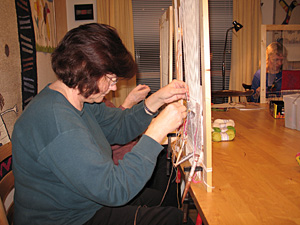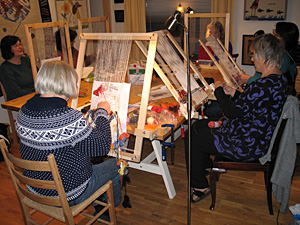TILBAKE
TEACHING TAPESTRY WITH A FOREIGN ACCENT
av Anne-Kirsti Espenes
Printed in Tapestry Weaver issue 5, september 2011 (Medlemsbladet til The British Tapestry Group)
 The last few years I have been teaching tapestry to various groups; School children, adult beginners, adults who have attended several traditional Norwegian tapestry courses and craft interested people who give classes to children. The way I teach is strongly influenced by the way I was taught to do tapestry myself. The last few years I have been teaching tapestry to various groups; School children, adult beginners, adults who have attended several traditional Norwegian tapestry courses and craft interested people who give classes to children. The way I teach is strongly influenced by the way I was taught to do tapestry myself.
My native country is Norway, and I had all my education before the age of twenty here. During a basic year in arts and craft, specializing in (cloth)weaving, I was convinced that tapestry 'was the thing to go for'. A Norwegian tutor adviced me to go to Edinburgh College of Art (ECA). And so I did in 1978.
Though I had not been taught how to do tapestry in Norway, I had seen enough to know quite well what it was all about. I brought with me a Norwegian tapestry frame across the North Sea, but it was never used. Compared with the simple Scottish frames, I found it too advanced: A strong spiral wire with exact tension, stretched from one upper edge to the other, was used as a reed. To change the spacing, the spiral wire had to be replaced by one with a different tension. My Norwegian frame simply did not fit in with was going on in Tapestry Department at ECA and the way Maureen Hodge and Fiona Mathison were running the cource. Some students wove their samplers and miniatures on old, second hand picture frames, just winding the warp around them, sometimes without a masking tape with inch marks on it. I had a simple wooden frame made by a frame maker just down the road from college.
These notes are not ment to be a negative critique of traditional Norwegian Tapestry weaving, but I cannot neglect the admiration and inspiration that was created in me when I saw what was made and the way it was woven in Scotland. In an American book from the early 70s, titled 'New Design in Weaving', by Donald J. Wilkings, I found this section:
"Scandinavia is undoubtedly
a fertile area for the contemporary weaver, but is still a place where the weaver is overhelmed by tradition and inhibited by too much tecnical competence. The ability to weave well has often become a substitute for the ability to weave creatively. And the weaver's vision as an artist has become so clouded by images from the past that he cannot see the wealth of explorative freedom just beyond the fingertips".
This was written about weaving in general, but it encompasses tapestry. I was a student in Edinburgh in 1978 to 1980, and I think this quotation expresses very well what popped up and started circulating in my textile mind. To emphasize what it is all about, I add another section from the same book:
"There is much too much emphasis on learning techniques for their own sake in Scandinavia, and not enough emphasis on really learning how to use them".
Years after my period at ECA, I went to Provence to do a summer cource i French Gobelin. I was introduced to the method of using a mirror and intricate hatchings. The tutor, Michelle Mesnage, was a master weaver educated at Les Gobelins in Paris. Back home I had a mirror made and attached to my loom. However, it was only used for one tapestry.
In 1997 I got a grant to do a tapestry module at West Dean. The eight weeks I spent there, strengthened my foreign tapestry accent even more. Pat Taylor gave the various tapestry techniques an historial aspect. On the very practical side, clamps were introduced to attach the simple, but ingenious tapestry frames to the table.
My next tapestry step abroad was made to Denmark in 2006 to attend a master class by Archie Brennan, His plumber pipe frames were possible to adjust tensionwise. Very good! And who else had thought of putting the frame in an easel? Knowing Archie's superb, graphic designs with lots of vertical lines where two colours meet, I was eager to learn his way of doing this. The notes I made during his class, have been studied over and over again. And Archies way of "sewing as you go" is obligatory in the samplers made at my tapestry courses.
Finally, I went to Italy in 2009 to spend a week at Lynne Curran's lovely place in Tuscany. Six days guided by her in her studio for sure added much not just to techniques, but also to the attitude and way of thinking tapestry.
 A good frame is important if you are to enjoy and manage weaving a small tapestry. So far my husband has made all my frames for the courses I have had. The participants can borrow them for free and are offered to buy them cheap. So far almost all frames have been sold. Lynne Curran showed me the brilliant clamps that can be bought from Handweaver's in London. What is so special about them is the fact that the frame can be moved up and down. Such a relief for one's shoulders! One of my course ladies' husband saw these clamps and managed to make a copy just as good. He is now busy making a pair for several makers of small tapestries. A good frame is important if you are to enjoy and manage weaving a small tapestry. So far my husband has made all my frames for the courses I have had. The participants can borrow them for free and are offered to buy them cheap. So far almost all frames have been sold. Lynne Curran showed me the brilliant clamps that can be bought from Handweaver's in London. What is so special about them is the fact that the frame can be moved up and down. Such a relief for one's shoulders! One of my course ladies' husband saw these clamps and managed to make a copy just as good. He is now busy making a pair for several makers of small tapestries.
Bobbins are not usual in Norway except for the tiny ones made for lace making. Butterflies and a fork to do the beating is common here. I prefer bobbins, but with lots of colours in a small area, a combination of butterflies and bobbins work well. I like to show some bobbins to my course participants and let them try them, but on the other hand it is not funny introducing a tool that cannot be bought here. So far at least three of my tapestry ladies have made a visit to Handweaver's in London to bye bobbins. And they bought a lot to provide for the rest of the course. One of them even sent her husband to do the deal when he was in London to watch his favourite football team. She had a SMS from him telling her that he hardly could handle visiting the shop because it turned out to be in the Arsenal area. His team was Tottenham.
Sewing slits is another part of my teaching that is not part of Norwegian tradition. Instead there are numerous variations of dovetailing and also interlocking. In my courses I introduce three ways of dooing vertical lines where two colours meet: "Sew as you go I", "Sew as you go II" and single interlocking. In "sew as you go I" one colour is woven up before the second one is woven and sewn to the first one in one operation. "Sew as you go II" means weaving the two vertical blocks at the same time and connecting them by an "invisible" thread making "figures of eight"around the two warp threads involved. I must admit that because I think these ways of handling slits work so well, I never really tried out the various dovetailing techniques.
I cannot finish these notes without mentioning another skill that clashes with my expectations about what to learn when I came to Edinburgh. I am thinking of what is called "inking on". Getting to know about the historical background connected to it, justified practising it. I dislike having a full scale drawing hanging behind the warp. "Inking on" in combination whith a small sketch works very well in my work. When I hand out a list of equipment to bring to my classes, "water proof feltpen" is one of the things to bring. New tapestry weavers like it and tend to continue inking on the warp.
To finish off, I will make a few comments on warp qualities. In Norway linen has been the main quality used for small traditional tapestries. I prefer linen for my bigger pieces of work, but I choose cotton for small frames. If there is a disadvantage with the simple, wooden frames that I have been praising in these notes, it must be the fact that the tension cannot be adjusted. The Norwegian frames with the spiral wire have threading on the vertical (metal) sides so that the tension may be altered a bit. Linen is less elastic than cotton and therefore less suitable for the wooden frames. Wool warp is popular among tapestry artists in Norway. A really good one is made by the Norwegian wool supplier Hoelfeldt Lund. I tried it on a wooden frame, but it did not work out well. A few days after warping up, the warp threads were loosend.
I find that teaching tapestry enriches my own work. Tapestry courses are not common at the moment in Norway. However, Norwegian weaving anthusiasts keep saying that tapestry weaving in general is on its way up again. Let's hope they are right.
Anne-Kirsti Espenes
|